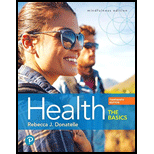
EBK HEALTH
13th Edition
ISBN: 9780134814506
Author: Donatelle
Publisher: YUZU
expand_more
expand_more
format_list_bulleted
Concept explainers
Question
Chapter 10, Problem 5PQ
Summary Introduction
To identify: The healthier fat included in the diet
Introduction:
Nutrition refers to a practice that determines the relationship between the key elements of the foods we take and physiological function. A good nutrition is a combination of regular physical activities and well-balanced diet.
Expert Solution & Answer
Want to see the full answer?
Check out a sample textbook solution
Chapter 10 Solutions
EBK HEALTH
Ch. 10 - Prob. 1WDYTCh. 10 - Prob. 2WDYTCh. 10 - Prob. 3WDYTCh. 10 - Prob. 1WDYSCh. 10 - What are your greatest concerns about GM foods?...Ch. 10 - In what ways could the creators of GM foods...Ch. 10 - What sort of regulation do you think the...Ch. 10 - Prob. 5WDYSCh. 10 - What is the most crucial nutrient for life? a....Ch. 10 - Prob. 2PQ
Knowledge Booster
Learn more about
Need a deep-dive on the concept behind this application? Look no further. Learn more about this topic, health-nutrition and related others by exploring similar questions and additional content below.Similar questions
- Bile has a role in _________ digestion and absorption. a. carbohydrate c. protein b. fat d. amino acidarrow_forwardEffects of Dietary Fats on Lipoprotein Levels Cholesterol that is made by the liver or that enters the body from food does not dissolve in blood, so it is carried through the bloodstream by lipoproteins. Low-density lipoprotein (LDL) carries cholesterol to body tissues such as artery walls, where it can form deposits associated with cardiovascular disease. Thus, LDL is often called bad cholesterol. Highdensity lipoprotein (HDL) carries cholesterol away from tissues to the liver for disposal, so HDL is often called good cholesterol. In 1990, Ronald Mensink and Martijn Katan published a study that tested the effects of different dietary fats on blood lipoprotein levels. Their results are shown in Figure 2.23. In which group was the level of LDL (bad cholesterol) highest?arrow_forwardEffects of Dietary Fats on Lipoprotein Levels Cholesterol that is made by the liver or that enters the body from food does not dissolve in blood, so it is carried through the bloodstream by lipoproteins. Low-density lipoprotein (LDL) carries cholesterol to body tissues such as artery walls, where it can form deposits associated with cardiovascular disease. Thus, LDL is often called bad cholesterol. Highdensity lipoprotein (HDL) carries cholesterol away from tissues to the liver for disposal, so HDL is often called good cholesterol. In 1990, Ronald Mensink and Martijn Katan published a study that tested the effects of different dietary fats on blood lipoprotein levels. Their results are shown in Figure 2.23. In which group was the level of HDL (good cholesterol) lowest?arrow_forward
- Effects of Dietary Fats on Lipoprotein Levels Cholesterol that is made by the liver or that enters the body from food does not dissolve in blood, so it is carried through the bloodstream by lipoproteins. Low-density lipoprotein (LDL) carries cholesterol to body tissues such as artery walls, where it can form deposits associated with cardiovascular disease. Thus, LDL is often called bad cholesterol. Highdensity lipoprotein (HDL) carries cholesterol away from tissues to the liver for disposal, so HDL is often called good cholesterol. In 1990, Ronald Mensink and Martijn Katan published a study that tested the effects of different dietary fats on blood lipoprotein levels. Their results are shown in Figure 2.23. Figure 2.23 Effect of diet on lipoprotein levels. Researchers placed 59 men and women on a diet in which 10 percent of their daily energy intake consisted of cis fatty acids, trans fatty acids, or saturated fats. Blood LDL and HDL levels were measured after three weeks on the diet; averaged results are shown in mg/dL (milligrams per deciliter of blood). All subjects were tested on each of the diets. The ratio of LDL to HDL is also shown. Source, Mensink RP, Katan MB, Effect of dietary trans fatty acids on high-density and low-density lipoprotein cholesterol levels in healthy subjects. NEJM 323(7):43945. An elevated risk of heart disease has been correlated with increasing LDL-to-HDL ratios. Rank the three diets according to their predicted effect on cardiovascular health.arrow_forwardWhich of the following statements is not true? a. Essential nutrients can be synthesized by the body. b. Vitamins are required in small quantities for bodily function. c. Some amino acids can be synthesized by the body, while others need to be obtained from diet. d. Vitamins come in two categories: fat-soluble and water-soluble.arrow_forward
arrow_back_ios
arrow_forward_ios
Recommended textbooks for you
 Comprehensive Medical Assisting: Administrative a...NursingISBN:9781305964792Author:Wilburta Q. Lindh, Carol D. Tamparo, Barbara M. Dahl, Julie Morris, Cindy CorreaPublisher:Cengage LearningHealth Safety And Nutrition F/Young ChildHealth & NutritionISBN:9781305144767Author:MAROTZPublisher:Cengage
Comprehensive Medical Assisting: Administrative a...NursingISBN:9781305964792Author:Wilburta Q. Lindh, Carol D. Tamparo, Barbara M. Dahl, Julie Morris, Cindy CorreaPublisher:Cengage LearningHealth Safety And Nutrition F/Young ChildHealth & NutritionISBN:9781305144767Author:MAROTZPublisher:Cengage




Comprehensive Medical Assisting: Administrative a...
Nursing
ISBN:9781305964792
Author:Wilburta Q. Lindh, Carol D. Tamparo, Barbara M. Dahl, Julie Morris, Cindy Correa
Publisher:Cengage Learning

Health Safety And Nutrition F/Young Child
Health & Nutrition
ISBN:9781305144767
Author:MAROTZ
Publisher:Cengage
